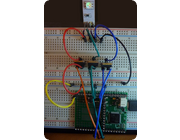
Simple LED wiring
Introduction
In order to power simple (analog) RGB LED strips, you need to translate between different voltage and/or want to have finer control over the output voltage to allow some dimming. Also, you may want to keep it simpler than with the WS2811 LEDs and only have one single color selectable for the entire strip. In this case a simple wiring with some transistors can be useful.
Wiring Up
In order to test this, a single LED (one color) would be enough, but you probably want to use this with an LED strip (probably '5050' tri-color type LEDs, which are fairly inexpensive).
As transistor you can use any power NPN or N-Channel MOSFET. However, for this example we have chosen the STP16NF06, which is quite inexpensive but yet powerful enough to drive dozens of LEDs (up to 16A!).
On the board you can either use the true analogue output pins A4, A5 (see DAC) or any pin supporting PWM output (which is nearly every pin). In this tutorial we are using the purely PWM pins C7, C8 & C9.

The MOSFETs can also be soldered directly onto the board as there are plenty of pins left on the prototype area.
Software
To power the LEDs type
analogWrite(C7, 1); // red
analogWrite(C8, 1); // green
analogWrite(C9, 1); // blue
This page is auto-generated from GitHub. If you see any mistakes or have suggestions, please let us know.